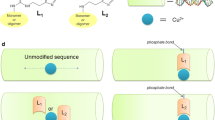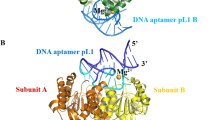Abstract
A study on the recognition of DNA sequence and conformational repair of sheared DNA by Novel Chiral Metal complex D,L-[Co(phen)2hpip]3+ (phen=1,10 phenanthroline, hpip=2-[2-hydroxyphenyl] imidazole [4,5-f][1,10] phenanthroline) is carried out with molecular simulations. The results reveal that two isomers of the complex could both recognize the normal DNA in the minor groove orientation, while recognize the sheared DNA in the major groove orientation and both isomers could convert the conformation of mismatched bases from sheared form to parallel form. Further analysis shows that the steric details of complex’s intercalation to base stack determine the results of recognition, which is induced by the steric collision among ancillary ligand phen, bases and DNA backbone, and by the steric crowding occurring in the process of structural expansion of bases and DNA backbone. Detailed analysis reveals that the conformational repair of mismatched bases relates not only to the steric interactions, but also the π-π stack among normal bases, mismatched bases and hpip ligand.
Similar content being viewed by others
References
Harfe, B. D., Jinks-Robertson, S., DNA mismatch repair and genetic instability, Annu. Rev. Genet., 2000, 34: 359–399.
Buermeyer, A. B., Deschenes, S. M., Baker, S. M. et al., Mammalian DNA mismatch repair, Annu. Rev. Genet., 1999, 33: 533–564.
Chen, H. L., Yang, P., Progress in the studies of mismatched nucleic acid, Progress in Chemistry (in Chinese), 2002, 14: 133–139.
Chen, H. L., Yang, P., Progress in the studies of recognition and repair of mismatched nucleic acid, Progress in Chemistry (in Chinese), 2002, 14: 239–245.
Erkkila, K. E., Odom, D. T., Barton, J. K., Recognition and reaction of metallointercalators with DNA, Chem. Rev., 1999, 19: 2777–2795.
Qi, D. F., Tann, C. M., Haring, D. et al., Generation of new enzymes via covalent modification of existing proteins, Chem. Rev., 2001, 101: 3081–3111.
Friedman, A. E., Kumar, C. V., Turro, N. J. et al., Luminescence of ruthenium(II) polypyridyls: evidence for intercalative binding to Z-DNA, Nucleic Acid Res., 1991, 19(10): 2595–2602.
Turro, C., Bossmann, S. H., Jenkins, Y. et al., Proton transfer quenching of the MLCT excited state of Ru(phen)2dppz2+ in homogeneous solution and bound to DNA, J. Am. Chem. Soc., 1995, 117: 9026–9032.
Yun, B. H., Kim, J. O., Lee, B. W. et al., Simultaneous binding of ruthenium(II) [(1,10-phenanthroline)2dipyridophenazine]2+ and minor groove binder 4′,6-diamidino-2-phenylindole to poly[d(A-T)2] at high binding densities: Observation of fluorescence resonance energy trasfer across the DNA stem, J. Phys. Chem. B, 2003, 107: 9858–9864.
Gisselfalt, K., Lincoln, P., Norden, B. et al., Interactions of tris(phenanthroline)ruthenium(II) enantiomers with DNA: Effects on helix flexibility studied by the electrophoretic behavior of reptating DNA in agarose gel, J. Phys. Chem. B, 2000, 104: 3651–3659.
Barton, J. K., Raphael, A. L., Photoactivated stereospecific cleavage of double-helical DNA by cobalt(III) complexes, J. Am. Chem. Soc., 1984, 106: 2466–2468.
Jackson, B. A., Alekseyev, V. Y., Barton, J. K., A versatile mismatch recognition agent: Specific cleavage of a plasmid DNA at a single base mispair, Biochemistry, 1999, 38: 4655–4662.
Collins, J. G., Sleeman, A. D., Aldrich-Wright, J. R. et al., A 1H NMR study of the DNA binding of ruthenium(II) polypyridyl complexes, Inorg. Chem., 1998, 37: 3133–3141.
Xiong, Z. H., Yang, P., Molecular modeling on recognition of sheared and normal DNA by novel metal complex L-and D-[Co(phen)2hpip]3+, J. Mol. Struc. (Theochem.), 2003, 620: 129–138.
Xiong, Z. H., Yang, P., Molecular modeling on recognition of DNA sequence by Λ-,Δ-[Co(phen)2hpip]3+, Chem. J. Chinese U. (in Chinese), 2002, 23(Supp.): 57–63.
Yang, P., Han, D. X., Molecular modeling of the binding mode of chiral metal complex Δ-and Λ-[Co(phen)2dppz]3+ with DNA, Science in China, Ser. B, 2000, 43(5): 516–523.
Xiong, Z. H., Yang, P., Studies of the interaction between sheared DNA and Λ-or Δ-[Ru(phen)2dppz]n+ by molecular modeling, J. Mol. Struc. (Theochem.), 2002, 582: 107–117.
Chen, H. L., Yang, P., A novel cobalt(III) mixed-polypyridy complex: Synthesis characterization and DNA binding, Chinese J. Chem., 2002, 20(6): 1529–1535.
Author information
Authors and Affiliations
Corresponding author
Rights and permissions
About this article
Cite this article
Wu, Y., Zhang, C. & Yang, P. Molecular modeling on the recognition of DNA sequence and conformational repair of sheared DNA by novel chiral metal complex D,L-[Co(phen)2hpip]3+ . SCI CHINA SER B 49, 177–185 (2006). https://doi.org/10.1007/s11426-006-0177-z
Received:
Accepted:
Published:
Issue Date:
DOI: https://doi.org/10.1007/s11426-006-0177-z




